Modern apartment buildings and schools crumbled, smoothly paved highways buckled and bridges collapsed — their flimsy construction no match for the awesome forces of nature.
As the death toll soars from Monday’s quake in Sichuan Province, the scale of the devastation is raising questions about the quality of China’s recent construction boom.
“This building is just a piece of junk,” one newly homeless resident of Dujiangyan yelled on Wednesday, her body quivering with rage.
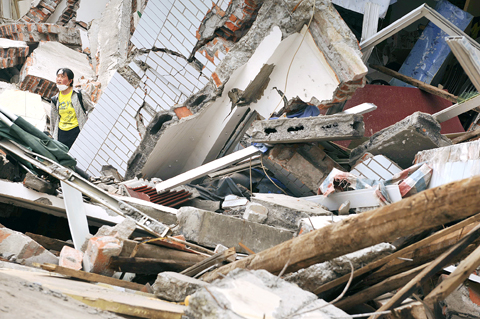
PHOTO: AFP
Her family salvaged clothing and mementos from their wrecked apartment, built when their older home was razed 10 years ago.
“The government tricked us. It told us this building was well constructed. But look at the homes all around us, they’re still standing,” said the woman, who would give only her surname, Chen.
Three decades of high-paced growth have remade China. But as the widespread devastation from Monday shows, the pell-mell pace has led some builders to cut corners, especially in outlying areas largely populated by the very young and the very old.
“This new economy in China is not going up safely, it’s going up fast, and the two don’t go together,” said Roger Bilham, a professor of geological sciences at the University of Colorado at Boulder.
“You look at the buildings that fell and they should not have fallen,” he said. “This is a story that has been repeated throughout the developing nations.”
New buildings in Beijing are built to exacting codes to withstand earthquakes.
However, “anti-earthquake standards are not as strict in places like Sichuan as in Shanghai,” said Ren Bing, an architectural designer at Hong Kong-based China Construction International Co.
Monday’s temblor flattened smaller towns in the disaster zone like Yingxiu. In Beichuan, entire blocks of apartments seemingly disintegrated. In Dujiangyan city, there was little evidence of steel reinforcement bars in the concrete rubble.
Other infrastructure old and new suffered as well. Nearly 400 dams, most of them small, were damaged across Sichuan.
Since the 1976 quake in Tangshan killed at least 240,000 people, the government has tried to improve building standards.
“China has been taking earthquake safety very seriously in the past 10 to 20 years,” said Susan Tubbesing, head of the California-based Earthquake Engineering Research Institute. “From what I understand, the codes China has adopted in the past 20 years have been good, solid, seismic codes.”
Chinese building codes are designed according to the level of shaking expected from a major temblor, said Claire Souch, senior director of model management at the consulting firm Risk Management Solutions, which is working with the Chinese to assess the damage.
In Sichuan, new buildings are built to withstand a shaking level of 7, Souch said.
But the magnitude-7.9 quake produced a shaking intensity of 10 near the epicenter, which usually results in total collapses.
“Essentially what happened is the actual ground shaking has far exceeded the design code for that region,” Souch said.
Another problem is that actual enforcement of building codes varies. The construction boom that has underpinned much of the stunning growth has also been an invitation for corruption, with officials and developers colluding.
In big cities, authorities generally enforce regulations. But that isn’t always true in smaller cities. And in rural areas, it’s out of the question, says Andrew Smeall, an associate at Asia Society’s Center on US-China Relations in New York.
A commentary in Wednesday’s state-run China Daily did question the staggering death toll, especially in schools wrecked by the quake, suggesting an investigation might find builders to blame.
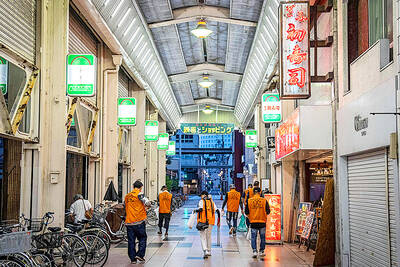
A missing fingertip offers a clue to Mako Nishimura’s criminal past as one of Japan’s few female yakuza, but after clawing her way out of the underworld, she now spends her days helping other retired gangsters reintegrate into society. The multibillion-dollar yakuza organized crime network has long ruled over Japan’s drug rings, illicit gambling dens and sex trade. In the past few years, the empire has started to crumble as members have dwindled and laws targeting mafia are tightened. An intensifying police crackdown has shrunk yakuza forces nationwide, with their numbers dipping below 20,000 last year for the first time since records
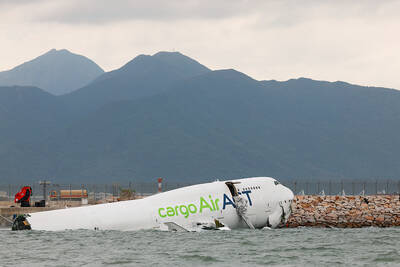
CAUSE UNKNOWN: Weather and runway conditions were suitable for flight operations at the time of the accident, and no distress signal was sent, authorities said A cargo aircraft skidded off the runway into the sea at Hong Kong International Airport early yesterday, killing two ground crew in a patrol car, in one of the worst accidents in the airport’s 27-year history. The incident occurred at about 3:50am, when the plane is suspected to have lost control upon landing, veering off the runway and crashing through a fence, the Airport Authority Hong Kong said. The jet hit a security patrol car on the perimeter road outside the runway zone, which then fell into the water, it said in a statement. The four crew members on the plane, which
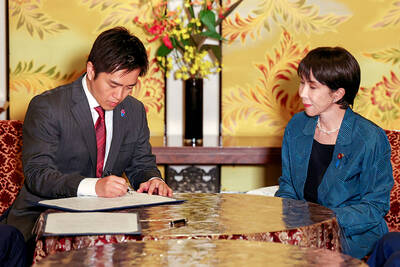
Japan’s ruling Liberal Democratic Party (LDP) and its junior partner yesterday signed a coalition deal, paving the way for Sanae Takaichi to become the nation’s first female prime minister. The 11th-hour agreement with the Japan Innovation Party (JIP) came just a day before the lower house was due to vote on Takaichi’s appointment as the fifth prime minister in as many years. If she wins, she will take office the same day. “I’m very much looking forward to working with you on efforts to make Japan’s economy stronger, and to reshape Japan as a country that can be responsible for future generations,”
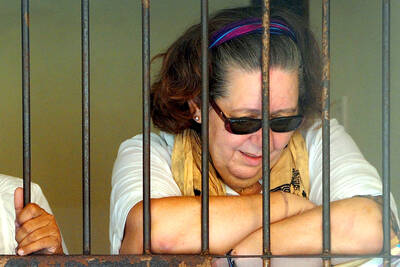
Indonesia was to sign an agreement to repatriate two British nationals, including a grandmother languishing on death row for drug-related crimes, an Indonesian government source said yesterday. “The practical arrangement will be signed today. The transfer will be done immediately after the technical side of the transfer is agreed,” the source said, identifying Lindsay Sandiford and 35-year-old Shahab Shahabadi as the people being transferred. Sandiford, a grandmother, was sentenced to death on the island of Bali in 2013 after she was convicted of trafficking drugs. Customs officers found cocaine worth an estimated US$2.14 million hidden in a false bottom in Sandiford’s suitcase when